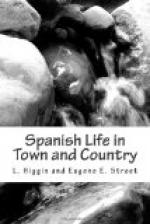CHAPTER XIV
PHILANTHROPY—POSITION OF WOMEN—MARRIAGE CUSTOMS
Travellers complain somewhat bitterly of the increase in the numbers and the importunity of beggars in Spain; but wherever monks abound, beggars also abound, and the long-unaccustomed sight of the various religious habits naturally brings with it the hordes of miserable objects who afford opportunities for the faithful to exercise what they are taught to believe is charity—loved of God. This, however, is more especially the case in Granada, or those favoured spots affected by the rich tourist, who has not always the same opinion about indiscriminate charity as the native Spaniard. In old days, the wise policy of Charles III. had reduced very greatly the swarm of beggars. A certain number of terrible-looking objects—the fortunate possessors of withered limbs, sightless eyeballs, or other disqualifications for honest work—still ostentatiously displayed their badges of professional mendicancy, and lived, apparently quite comfortably, on the alms of the passers-by. But the enormous competition which has since sprung up in this “career” must interfere a good deal with its lucrativeness.
There is no poor law as yet in Spain. Philanthropy is left to voluntary effort; but the list of charities is so great, and so widely spread over the whole country, that one would think wholesale beggary would be superfluous. Madrid is divided into thirty-three parishes, each having a board of Beneficencias, the Government holding a fund which these boards administer. The Queen is the President of the whole. Each board has its president and vice-president—generally ladies of the aristocracy—a treasurer, vice-treasurer, secretary, and vice-secretary, and a body of visitors; accounts are rendered monthly to the governing board, whose vice-president presides in the name of the Queen. There are also the confraternities of St. Vincent and St. Paul, the members of which are gentlemen and ladies who work independently of each other. These, however, have no established funds, but depend on voluntary subscriptions and gifts. Both these associations visit the poor in their own homes. The Pardo and the San Bernadino are societies and homes for benefiting men, women, and children; they have been founded by ladies. For boys there is the School of the Sacred Heart, and the Christian Brothers. The School of San Ildefonso belongs to the Ayuntamiento, and has secular masters. There is a small asylum, with chaplaincy attached, for architects. Santa Rita is a reformatory for boys in Carabanchel, under a religious brotherhood. For girls there is the Horfino, the Mercedes Asylum—founded in memory of and kept up by the rents of Queen Mercedes—Santa Isabel and San Ildefonso, the French St. Vincent de Paul, San Blas, on the same lines as the Mercedes, Santa Cruz, the Inclusa, and the Spanish Vincent de Paul. For fallen girls there are the Adorers of the Blessed Sacrament, the Ladies of the Holy Trinity, and the Oblates of the Holy Redeemer.




